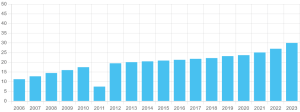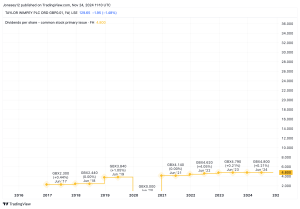At the moment, there’s a little bit of cash sitting in my ISA that’s being eroded by inflation.
Ideally, I’d like to use it to buy another income stock. But at the risk of sounding greedy, I’d also hope to achieve some capital growth.
One option
Taylor Wimpey (LSE:TW.) has been on my radar for some time as a potential stock to add to my portfolio.
Due to well documented problems in the housing market, it built 23% fewer homes in 2023 (10,848) than it did in 2022 (14,154).
But with the Bank of England starting to cut interest rates, I’m hopeful that the sector will soon start to recover. In 2024, the UK’s most valuable builder is expecting nearly 10,000 completions, which is at the upper end of its previous guidance.
In respect of the year ended 31 December 2023, the company paid a dividend of 9.57p a share. Based on a current (1 November) share price of 146p, the stock’s currently offering a yield of 6.6%. The average for the FTSE 100 is 3.7%.
What’s more, now could be a good time for me to invest. The company’s share price is 13% lower than its 52-week high, achieved in the middle of September.
Getting Britain building again
Since the general election, all of the FTSE 100’s builders have enjoyed a bit of a resurgence.
The government’s emphasis on planning reforms and building more social housing appears to have gone down well with investors.
But in recent weeks this optimism (and mine) has faded slightly.
I suspect investors have realised that Taylor Wimpey’s post-pandemic problems — it reported an operating profit in 2023 of £416m, compared to £851m in 2019 — have been caused by a lack of demand, rather than a shortage of land on which to build.
At 31 December 2023, the company owned 38,952 plots with detailed planning consent. And a further 28,083 with outline permission. At current run rates, this is equivalent to over six years’ completions.
Frustration
However, in my opinion, the government’s doing very little to stimulate demand. The Budget on 30 October, didn’t contain any incentives to help first-time buyers.
Indeed, the Chancellor announced plans — with effect from April 2025 — to reduce the stamp duty threshold for those looking to get on the housing ladder to £300,000.
According to Zoopla, an additional 20% of first-time buyers will be liable to pay the duty at the full rate and a further 14% will be required to pay a partial amount.
This means Taylor Wimpey will be relying on a lower interest rate environment and an increase in disposable incomes (rather than government incentive schemes) if it’s to return to previous levels of activity.
But some economists believe the government’s intention to borrow more for infrastructure projects will keep interest rates higher for longer.
And following the Budget, from 2027 onwards, the Office for Budget Responsibility’s UK growth forecast has been downgraded. The Resolution Foundation is predicting disposable incomes to increase by an annual average of only 0.5% over the next five years.
This rather gloomy outlook makes me less optimistic about the prospects for Britain’s housebuilders than previously. I’m therefore going to keep Taylor Wimpey on my watchlist and look for something else to include in my Stocks and Shares ISA.
This post was originally published on Motley Fool






